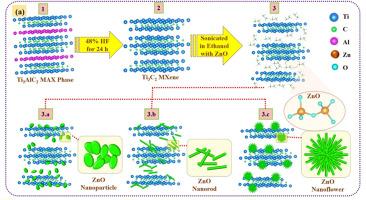Synergistic advancements in MXene-ZnO interfacial engineering for triboelectric nanogenerators and pulsed-power supercapacitors
IF 7.9
2区 工程技术
Q1 CHEMISTRY, PHYSICAL
引用次数: 0
Abstract
The advent of self-powered supercapacitors signs a transformative increase in energy storage, seamlessly integrating triboelectric nanogenerators (TENGs) for self-governing energy harvesting. Two-dimensional MXenes, celebrated for their superior electrical conductivity and tunable surface chemistry, emerge as compelling candidates for supercapacitor electrodes and triboelectric layers. However, intrinsic restacking tendencies hinder ion diffusion and limit charge storage capabilities. To overcome this constraint, a sonication-assisted hybridization of MXene with morphologically distinct ZnO nanostructures (nanoparticles (ZNP), nanorods (ZNR), and nanoflowers (ZNF)) was meticulously engineered. Density of States (DOS) analysis elucidates a profound enhancement in electronic conductivity and active surface sites, corroborated by effective potential calculations that confirm improved charge transport dynamics. A PVDF_MXene_ZnO nanofiber-based TENG, incorporating 15 wt% ZNF, yielded an astounding peak voltage of 1010 V and a power density of 355.59 μW/cm2 under a mechanical force of 40 N at 8 Hz. Electrochemical evaluations in 1 M K2SO4 electrolyte revealed that MXene_ZnO (5 wt% ZNF) electrodes achieved an exceptional capacitance of 340 F/g at 3 A/g, retaining 86.86 % stability over 10,000 cycles. A symmetric supercapacitor demonstrated an energy density of 4.79 Wh/kg and a power density of 972 W/kg, efficiently powering LEDs and real-time traffic signals. These findings solidify MXene-ZnO as a frontier material, advancing the scope of self-powered energy storage for next-generation sustainable electronics and intelligent power grids.

摩擦纳米发电机和脉冲功率超级电容器中MXene-ZnO界面工程的协同进展
自供电超级电容器的出现标志着能量存储的革命性增长,无缝集成摩擦电纳米发电机(TENGs)用于自我能量收集。二维MXenes以其优越的导电性和可调的表面化学特性而闻名,成为超级电容器电极和摩擦电层的有力候选者。然而,固有的再堆积倾向阻碍了离子扩散并限制了电荷存储能力。为了克服这一限制,我们精心设计了一种超声辅助MXene与形态不同的ZnO纳米结构(纳米颗粒(ZNP),纳米棒(ZNR)和纳米花(ZNF))的杂交。态密度(DOS)分析阐明了电子电导率和活性表面位点的深刻增强,有效电位计算证实了电荷输运动力学的改善。在8 Hz、40 N的机械力作用下,PVDF_MXene_ZnO纳米纤维的峰值电压达到1010 V,功率密度达到355.59 μW/cm2。在1 M K2SO4电解液中的电化学评价表明,MXene_ZnO (5 wt% ZNF)电极在3 A/g下获得了340 F/g的优异电容,在10,000次循环中保持了86.86%的稳定性。对称超级电容器的能量密度为4.79 Wh/kg,功率密度为972 W/kg,可有效地为led和实时交通信号供电。这些发现巩固了MXene-ZnO作为前沿材料的地位,推进了下一代可持续电子和智能电网的自供电储能范围。
本文章由计算机程序翻译,如有差异,请以英文原文为准。
求助全文
约1分钟内获得全文
求助全文
来源期刊

Journal of Power Sources
工程技术-电化学
CiteScore
16.40
自引率
6.50%
发文量
1249
审稿时长
36 days
期刊介绍:
The Journal of Power Sources is a publication catering to researchers and technologists interested in various aspects of the science, technology, and applications of electrochemical power sources. It covers original research and reviews on primary and secondary batteries, fuel cells, supercapacitors, and photo-electrochemical cells.
Topics considered include the research, development and applications of nanomaterials and novel componentry for these devices. Examples of applications of these electrochemical power sources include:
• Portable electronics
• Electric and Hybrid Electric Vehicles
• Uninterruptible Power Supply (UPS) systems
• Storage of renewable energy
• Satellites and deep space probes
• Boats and ships, drones and aircrafts
• Wearable energy storage systems
 求助内容:
求助内容: 应助结果提醒方式:
应助结果提醒方式:


